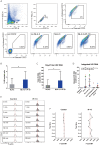IP-10 Promotes Latent HIV Infection in Resting Memory CD4+ T Cells via LIMK-Cofilin Pathway
- PMID: 34447368
- PMCID: PMC8383741
- DOI: 10.3389/fimmu.2021.656663
IP-10 Promotes Latent HIV Infection in Resting Memory CD4+ T Cells via LIMK-Cofilin Pathway
Abstract
A major barrier to HIV eradication is the persistence of viral reservoirs. Resting CD4+ T cells are thought to be one of the major viral reservoirs, However, the underlying mechanism regulating HIV infection and the establishment of viral reservoir in T cells remain poorly understood. We have investigated the role of IP-10 in the establishment of HIV reservoirs in CD4+ T cells, and found that in HIV-infected individuals, plasma IP-10 was elevated, and positively correlated with HIV viral load and viral reservoir size. In addition, we found that binding of IP-10 to CXCR3 enhanced HIV latent infection of resting CD4+ T cells in vitro. Mechanistically, IP-10 stimulation promoted cofilin activity and actin dynamics, facilitating HIV entry and DNA integration. Moreover, treatment of resting CD4+ T cells with a LIM kinase inhibitor R10015 blocked cofilin phosphorylation and abrogated IP-10-mediated enhancement of HIV latent infection. These results suggest that IP-10 is a critical factor involved in HIV latent infection, and that therapeutic targeting of IP-10 may be a potential strategy for inhibiting HIV latent infection.
Keywords: CXCL10; HIV reservoir; cofilin; latent infection; resting memory CD4+ T cells.
Copyright © 2021 Wang, Yin, Ma, Ge, Lang, Sun, He, Fu, Sun, Yu, Zhang, Cui, Han, Xu, Ding, Chu, Shang, Wu and Jiang.
Conflict of interest statement
The authors declare that the research was conducted in the absence of any commercial or financial relationships that could be construed as a potential conflict of interest.
Figures







Similar articles
-
Transforming Growth Factor β Signaling Promotes HIV-1 Infection in Activated and Resting Memory CD4+ T Cells.J Virol. 2023 May 31;97(5):e0027023. doi: 10.1128/jvi.00270-23. Epub 2023 Apr 12. J Virol. 2023. PMID: 37042759 Free PMC article.
-
LIM kinase 1 modulates cortical actin and CXCR4 cycling and is activated by HIV-1 to initiate viral infection.J Biol Chem. 2011 Apr 8;286(14):12554-64. doi: 10.1074/jbc.M110.182238. Epub 2011 Feb 14. J Biol Chem. 2011. PMID: 21321123 Free PMC article.
-
The Effect of JAK1/2 Inhibitors on HIV Reservoir Using Primary Lymphoid Cell Model of HIV Latency.Front Immunol. 2021 Aug 31;12:720697. doi: 10.3389/fimmu.2021.720697. eCollection 2021. Front Immunol. 2021. PMID: 34531866 Free PMC article.
-
Relationships Between HIV-Mediated Chemokine Coreceptor Signaling, Cofilin Hyperactivation, Viral Tropism Switch and HIV-Mediated CD4 Depletion.Curr HIV Res. 2019;17(6):388-396. doi: 10.2174/1570162X17666191106112018. Curr HIV Res. 2019. PMID: 31702526 Review.
-
Peering into the HIV reservoir.Rev Med Virol. 2018 Jul;28(4):e1981. doi: 10.1002/rmv.1981. Epub 2018 May 9. Rev Med Virol. 2018. PMID: 29744964 Free PMC article. Review.
Cited by
-
Characterization of a CXCR4 antagonist TIQ-15 with dual tropic HIV entry inhibition properties.PLoS Pathog. 2024 Aug 15;20(8):e1012448. doi: 10.1371/journal.ppat.1012448. eCollection 2024 Aug. PLoS Pathog. 2024. PMID: 39146384 Free PMC article.
-
The reservoir of latent HIV.Front Cell Infect Microbiol. 2022 Jul 28;12:945956. doi: 10.3389/fcimb.2022.945956. eCollection 2022. Front Cell Infect Microbiol. 2022. PMID: 35967854 Free PMC article. Review.
-
Negative Regulation and Protective Function of Natural Killer Cells in HIV Infection: Two Sides of a Coin.Front Immunol. 2022 Mar 7;13:842831. doi: 10.3389/fimmu.2022.842831. eCollection 2022. Front Immunol. 2022. PMID: 35320945 Free PMC article. Review.
-
Controversies in the Design of Strategies for the Cure of HIV Infection.Pathogens. 2023 Feb 15;12(2):322. doi: 10.3390/pathogens12020322. Pathogens. 2023. PMID: 36839593 Free PMC article. Review.
-
A cohort-based study of host gene expression: tumor suppressor and innate immune/inflammatory pathways associated with the HIV reservoir size.PLoS Pathog. 2023 Nov 29;19(11):e1011114. doi: 10.1371/journal.ppat.1011114. eCollection 2023 Nov. PLoS Pathog. 2023. PMID: 38019897 Free PMC article.
References
-
- Fidler S SW, Pace M, Dorrell L, Lever A, Pett S, et al. . A Randomised Controlled Trial Comparing the Impact of Antiretroviral Therapy (ART) With A’Kick-and-Kill’ Approach to ART Alone on HIV Reservoirs in Individuals With Primary HIV Infection (PHI); RIVER Trial [Abstract TUAA0202LB], in: 22nd International AIDS Conference (2018). Amsterdam: (Accessed 12 November 2018).
-
- Stacey AR, Norris PJ, Qin L, Haygreen EA, Taylor E, Heitman J, et al. . Induction of a Striking Systemic Cytokine Cascade Prior to Peak Viremia in Acute Human Immunodeficiency Virus Type 1 Infection, in Contrast to More Modest and Delayed Responses in Acute Hepatitis B and C Virus Infections. J Virol (2009) 83(8):3719–33. 10.1128/JVI.01844-08 - DOI - PMC - PubMed
Publication types
MeSH terms
Substances
LinkOut - more resources
Full Text Sources
Medical
Research Materials

